Effect of Nanoparticle Morphology on Pre-Breakdown and Breakdown Properties of Insulating Oil-Based Nanofluids
Abstract
1. Introduction
2. Experiment
2.1. Materials
2.2. Preparation of Insulating Oil-Based Nanofluids
2.3. Characterization and Measurement
3. Results and Discussion
3.1. Nanoparticle Morphology
3.2. Breakdown Property
3.3. Pre-breakdown Streamer Propagation
3.4. Discussion
4. Conclusions
Author Contributions
Funding
Acknowledgments
Conflicts of Interest
References
- Guo, N.; Dibenedetto, S.A.; Tewari, P.; Lanagan, M.T.; Ratner, M.A.; Marks, T.J. Nanoparticle, size, shape, and interfacial effects on leakage current density, permittivity, and breakdown strength of metal oxide−polyolefin nanocomposites: Experiment and theory. Chem. Mater. 2010, 22, 1567–1578. [Google Scholar] [CrossRef]
- Paszkiewicz, S.; Szymczyk, A.; Pawlikowska, D.; Subocz, J.; Zenker, M.; Masztak, R. Electrically and thermally conductive low density polyethylene-based nanocomposites reinforced by MWCNT or Hybrid MWCNT/Graphene nanoplatelets with improved thermo-oxidative stability. Nanomaterials 2018, 8, 264. [Google Scholar] [CrossRef] [PubMed]
- Dung, N.V.; Hoidalen, H.K.; Linhjell, D.; Lundgaard, L.E.; Unge, M. Influence of impurities and additives on negative streamers in paraffinic model oil. IEEE Trans. Dielectr. Electr. Insul. 2012, 20, 876–886. [Google Scholar] [CrossRef]
- Lesaint, O.; Jung, M. On the relationship between streamer branching and propagation in liquids: Influence of pyrene in cyclohexane. J. Phys. D: Appl. Phys. 2000, 33, 1360–1368. [Google Scholar] [CrossRef]
- Unge, M.; Singha, S.; Dung, N.V.; Linhjell, D.; Ingebrigtsen, S.; Lundgaard, L.E. Enhancements in the lightning impulse breakdown characteristics of natural ester dielectric liquids. Appl. Phys. Lett. 2013, 102, 172905. [Google Scholar] [CrossRef]
- Massala, G.; Lesaint, O. A comparison of negative and positive streamers in mineral oil at large gaps. J. Phys. D Appl. Phys. 2001, 34, 1525. [Google Scholar] [CrossRef]
- Furusato, T.; Tanoue, H.; Katsuki, S.; Hara, M.; Akiyama, H. Prebreakdown process of a negative nanosecond pulsed discharge in supercritical carbon dioxide. Appl. Phys. Lett. 2014, 7, 343–352. [Google Scholar] [CrossRef]
- Segal, V.; Hjortsberg, A.; Rabinovich, A.; Nattrass, D.; Raj, K. AC (60 Hz) and impulse breakdown strength of a colloidal fluid based on transformer oil and magnetite nanoparticles. IEEE Int. Sympos. Electr. Insul. 1998, 2, 619–622. [Google Scholar]
- Du, Y.; Lv, Y.; Li, C.; Chen, M.; Zhou, J.; Li, X.; Zhou, Y.; Tu, Y. Effect of electron shallow trap on breakdown performance of transformer oil-based nanofluids. J. Appl. Phys. 2011, 110, 104104. [Google Scholar] [CrossRef]
- Sartoratto, P.; Neto, A.; Lima, E.; Rodrigues, S.A.; Morais, P.C. Preparation and electrical properties of oil-based magnetic fluids. J. Appl. Phys. 2005, 97, 10Q917. [Google Scholar] [CrossRef]
- Mimura, K.; Kato, K. Enhanced dielectric properties of BaTiO3 nanocube assembled film in metal-insulator-metal capacitor structure. Appl. Phys. Express 2014, 7, 61501. [Google Scholar] [CrossRef]
- Yang, Q.; Yu, F.; Sima, W.; Yuan, T.; Jin, Y.; Song, H. Inhibition effect of space charge transportation on impulse breakdown performance of propylene carbonate with Al2O3 nanoparticles. Appl. Phys. Lett. 2015, 106, 513–612. [Google Scholar] [CrossRef]
- Du, Y.; Lv, Y.; Li, C.; Chen, M.; Zhong, Y.; Zhou, J.; Li, X.; Zhou, Y. Effect of semiconductive nanoparticles on insulating performances of transformer oil. IEEE Trans. Dielectr. Electr. Insul. 2012, 19, 770–776. [Google Scholar]
- Sima, W.X.; Cao, X.F.; Yang, Q.; Song, H.; Shi, J. Preparation of three transformer oil-based nanofluids and comparison of their impulse breakdown characteristics. Nanosci. Nanotechnol. Lett. 2014, 6, 250–256. [Google Scholar] [CrossRef]
- Liu, R.; Pettersson, L.A.A.; Auletta, T.; Hjortstam, O. Fundamental research on the application of nano dielectrics to transformers. In Proceedings of the 2011 Annual Report Conference on Electrical Insulation and Dielectric Phenomena, Cancun, Mexico, 16–19 October 2011; pp. 423–427. [Google Scholar]
- Yao, W.; Huang, Z.; Li, J.; Wu, L.; Xiang, C. Enhanced electrical insulation and heat transfer performance of vegetable oil based nanofluids. J. Nanomater. 2018, 7, 1–12. [Google Scholar] [CrossRef]
- Taylor, R.; Coulombe, S.; Otanicar, T.; Phelan, P. Small particles, big impacts: A review of the diverse applications of nanofluids. J. Appl. Phys. 2013, 113, 011301. [Google Scholar] [CrossRef]
- Gonzalo-Juan, I.; McBride, R.J.; Dickerson, H.J. Ligand-mediated shape control in the solvothermal synthesis of titanium dioxide nanospheres, nanorods and nanowires. Nanoscale 2011, 3, 3799–3804. [Google Scholar] [CrossRef] [PubMed]
- Council on Large Electric Systems (CIGRE). Effect of Particles on Transformer Dielectric Strength; Working Group 17 of Study Committee; Council on Large Electric Systems: Paris, France, 2000. [Google Scholar]
- De, J.N.; Ross, F.M. Electron microscopy of specimens in liquid. Nat. Nanotechnol. 2011, 6, 695–704. [Google Scholar]
- Ross, F.M. Opportunities and challenges in liquid cell electron microscopy. Science 2015, 350, aaa9886. [Google Scholar] [CrossRef] [PubMed]
- Lv, Y.; Ge, Y.; Li, C.; Wang, Q.; Zou, Y.; Qi, B.; Yi, K.; Chen, X.; Yuan, J. Effect of TiO2 nanoparticles on streamer propagation in transformer oil under lightning impulse voltage. IEEE Trans. Dielectr. Electr. Insul. 2016, 23, 2110–2115. [Google Scholar] [CrossRef]
- Kim, E.Y.; Choi, H.; Whang, C.M. Controlled growth of TiO2 nanorods capped with carboxylate groups by the solvothermal process. J. Mater. Sci. 2010, 45, 3895–3900. [Google Scholar] [CrossRef]
- Jadidian, J.; Zahn, M.; Lavesson, N.; Widlund, O.; Borg, K. Impulse breakdown delay in liquid dielectrics. Appl. Phys. Lett. 2012, 100, 192910. [Google Scholar] [CrossRef]
- Dung, N.V.; Høidalen, H.K.; Linhjell, D.; Lundgaard, L.E.; Unge, M. Effects of reduced pressure and additives on streamers in white oil in long point-plane gap. J. Phys. D Appl. Phys. 2013, 46, 255501–255516. [Google Scholar] [CrossRef]
- Beroual, A.; Zahn, M.; Badent, A.; Kist, K.; Schwabe, A.J.; Yamashita, H.; Yamazawa, K.; Danikas, M.; Chadband, W.G.; Torshin, Y. Propagation and structure of streamers in liquid dielectrics. IEEE Trans. Electr. Insul. Mag. 1998, 14, 6–17. [Google Scholar] [CrossRef]
- Dung, N.V.; Hoidalen, H.K.; Linhjell, D.; Lundgaard, L.E.; Unge, M. Influence of impurities and additives on positive streamers in paraffinic model oil. IEEE Trans. Dielectr. Electr. Insul. 2012, 19, 1593–1603. [Google Scholar] [CrossRef]
- Wang, Z.; Liu, J.; Cheng, Y.; Chen, S.; Yang, M.; Huang, J.; Wang, H.; Wu, G.; Wu, H. Alignment of boron nitride nanofibers in epoxy composite films for thermal conductivity and dielectric breakdown strength improvement. Nanomaterials 2018, 8, 242. [Google Scholar] [CrossRef] [PubMed]
- Wang, Y.; Wang, C.; Zhang, Z.; Xiao, K. Effect of nanoparticles on the morphology, thermal, and electrical properties of low-density polyethylene after thermal aging. Nanomaterials 2017, 7, 320. [Google Scholar] [CrossRef] [PubMed]
- Lewis, T.J. Interfaces: Nanometric dielectrics. J. Phys. D: Appl. Phys. 2005, 38, 202–212. [Google Scholar] [CrossRef]
- Tanaka, T. Dielectric nanocomposites with insulating properties. IEEE Trans. Dielectr. Electr. Insul. 2005, 12, 914–928. [Google Scholar] [CrossRef]
- Nelson, J.K. Dielectric Polymer Nanocomposites, 7th ed.; Springer: New York, NY, USA, 2010; pp. 198–226. [Google Scholar]
- Tanaka, T.; Matsunawa, A.; Ohki, Y.; Kozako, M.; Kohtoh, M.; Okabe, S. Treeing Phenomena in Epoxy/Alumina Nanocomposite and Interpretation by a Multi-core Model. IEEJ Trans. Fund. Mater. 2007, 126, 1128–1135. [Google Scholar] [CrossRef]
- Zerjav, G.; Arshad, M.S.; Djinovic, P.; Junkar, I.; Kovac, J.; Zavasnik, J.; Pintar, A. Improved electron-hole separation and migration in anatase TiO2 nanorod/reduced graphene oxide composites and their influence on photocatalytic performance. Nanoscale 2017, 9, 4578–4592. [Google Scholar] [CrossRef] [PubMed]
- Nam, S.H.; Ju, D.W.; Boo, J.H. Comparison of photovoltaic properties of TiO2 electrodes prepared with nanoparticles and nanorods. J. Nanosci. Nanotechnol. 2014, 14, 9406–9410. [Google Scholar] [CrossRef] [PubMed]
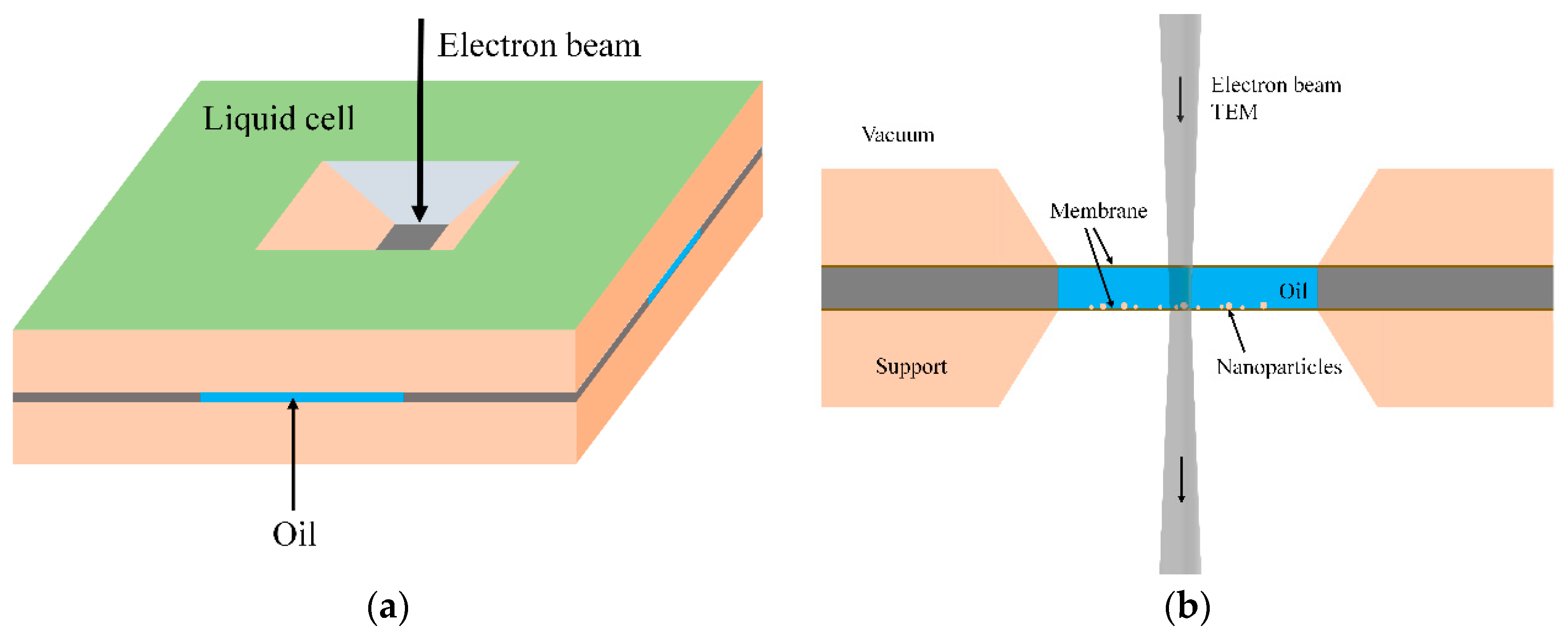
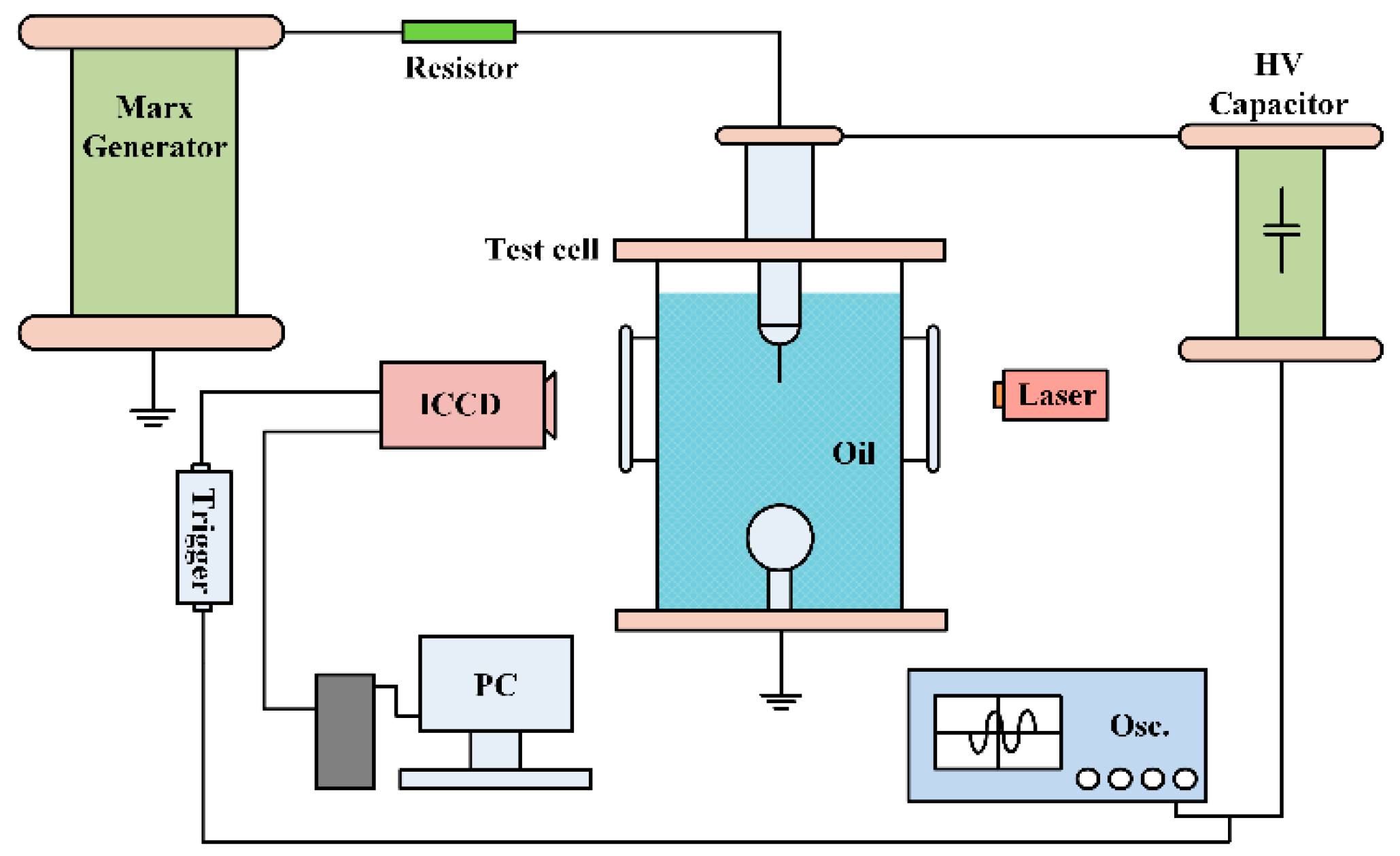
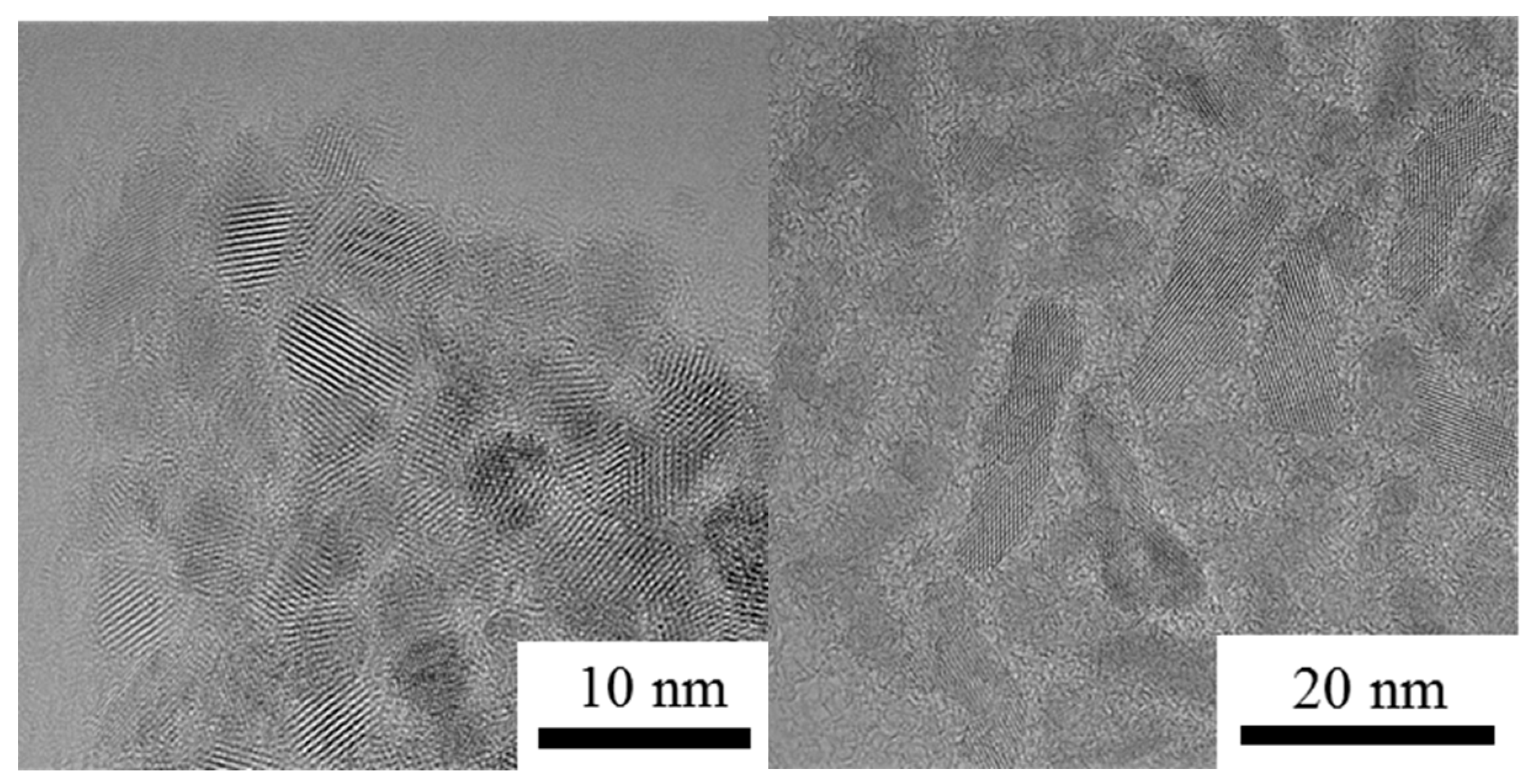
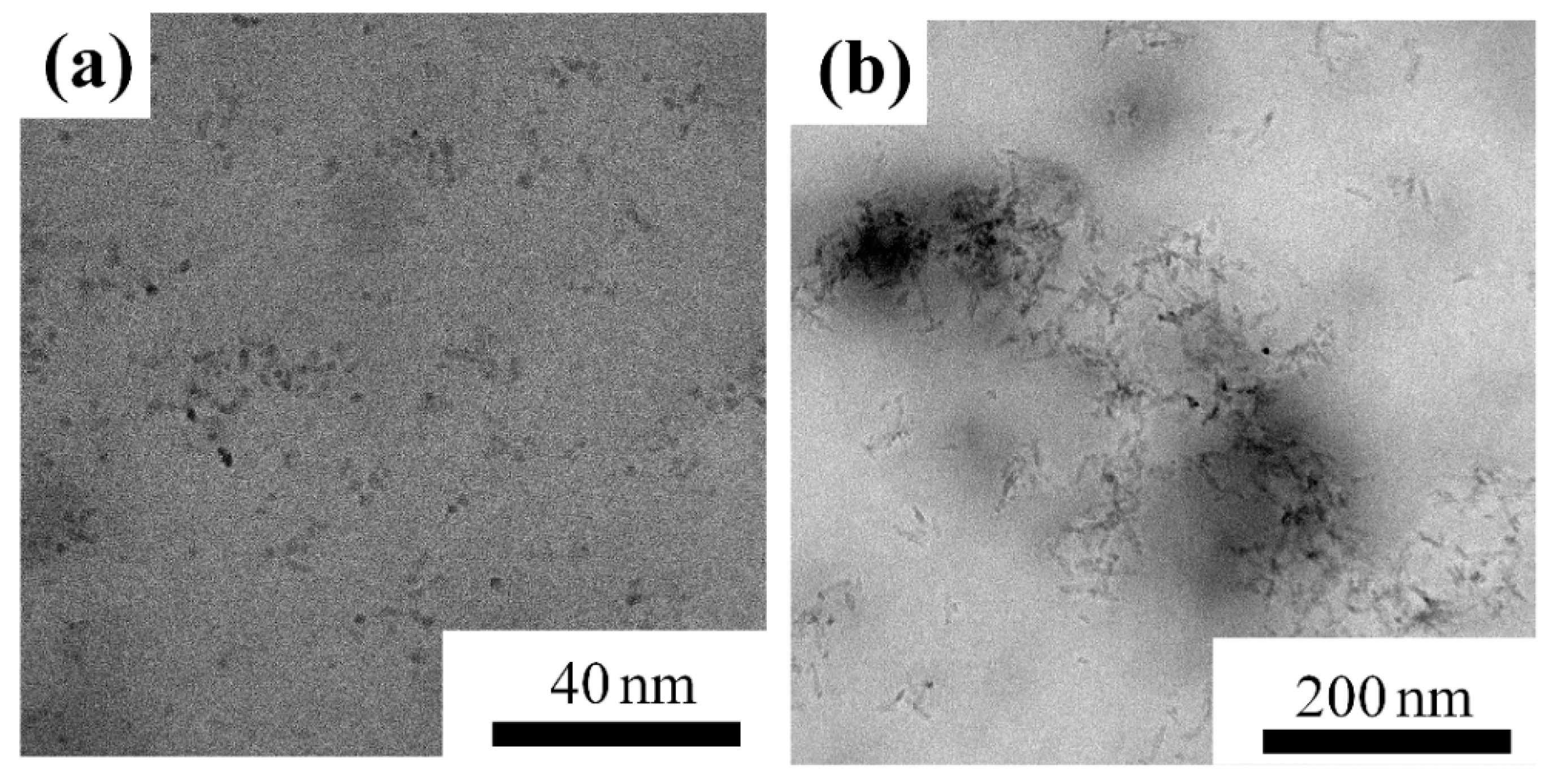
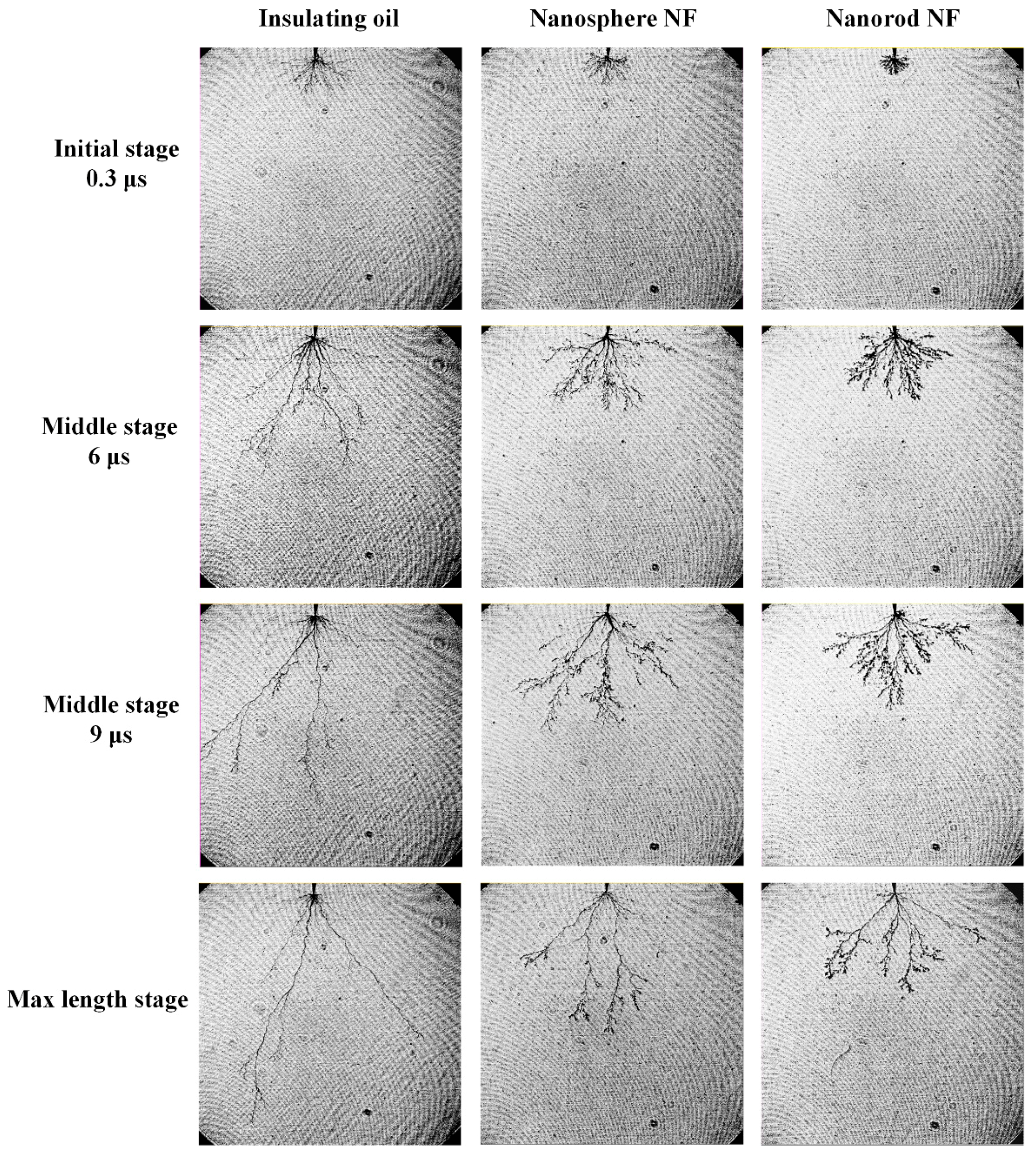
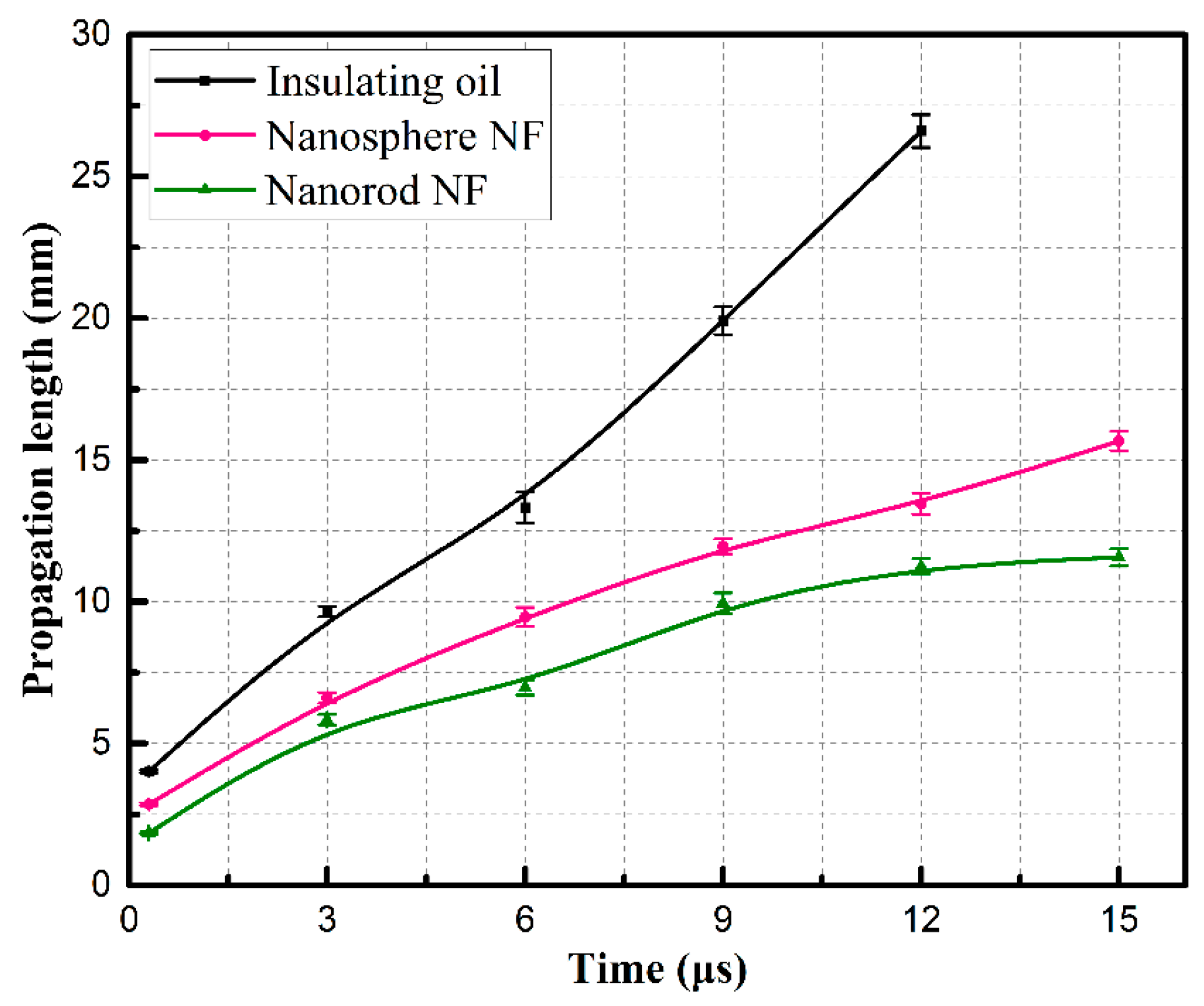
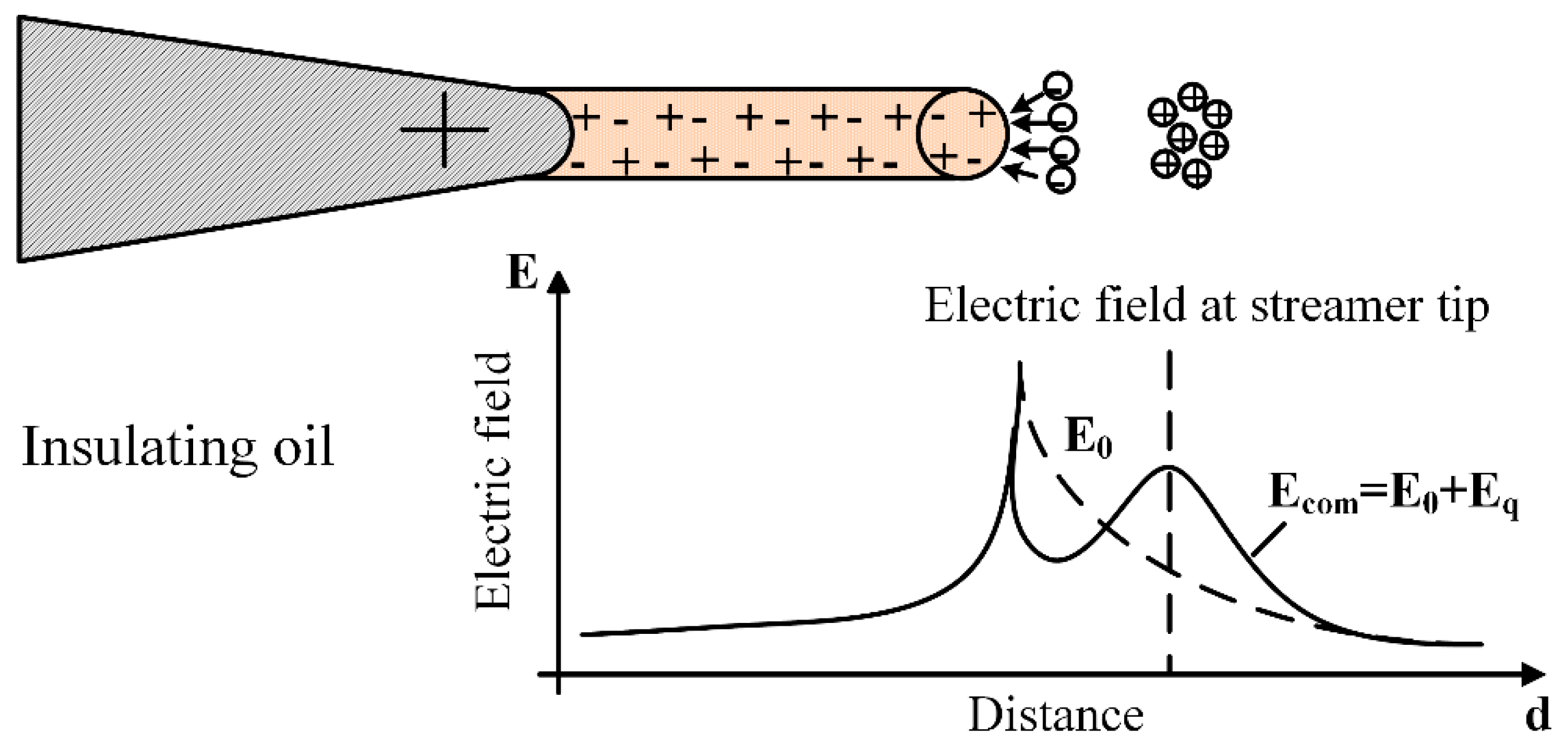

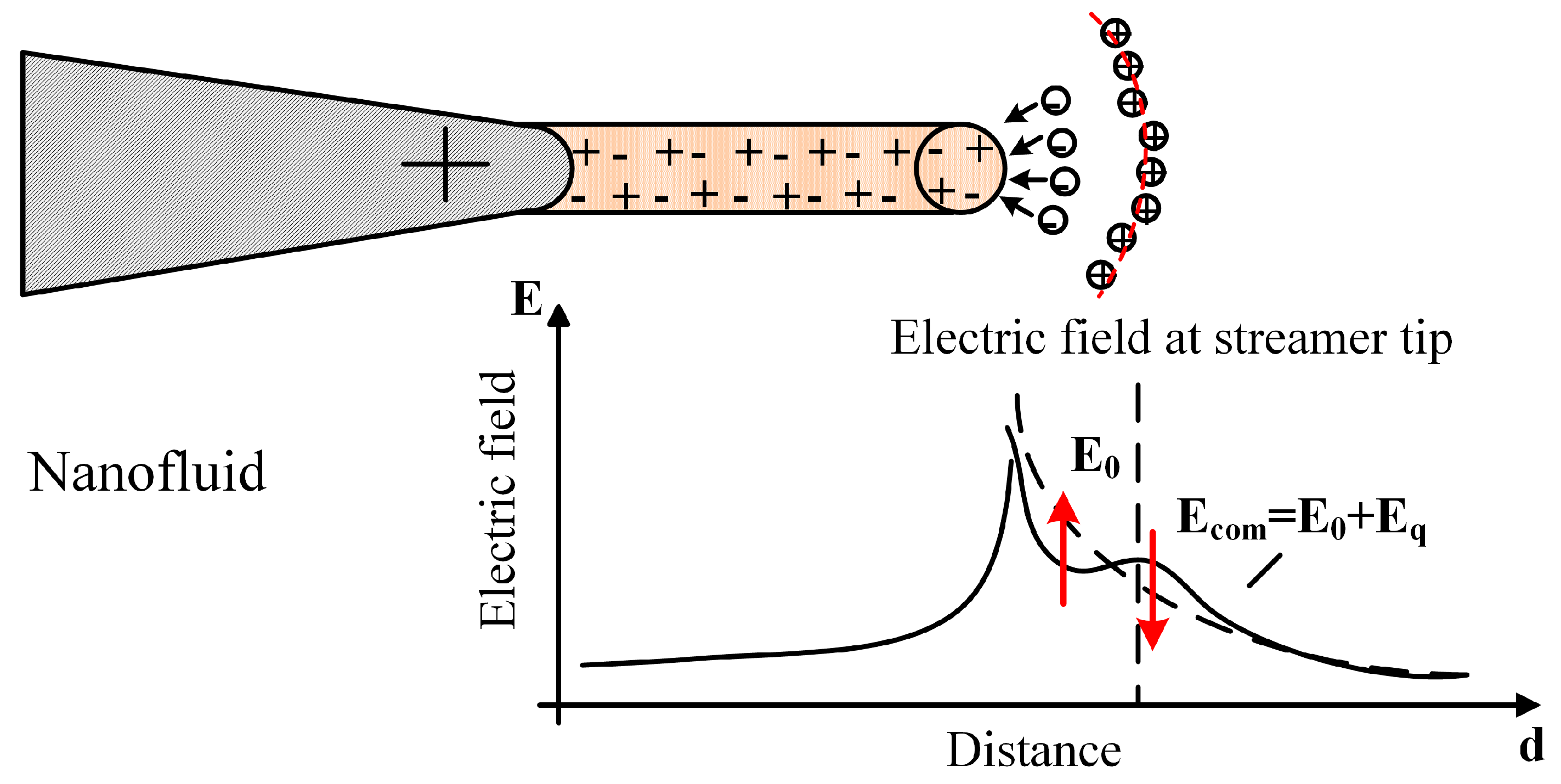
| Sample | Breakdown Voltage (kV) | Standard Deviation (kV) | Time to Breakdown (μs) | Standard Deviation (μs) |
|---|---|---|---|---|
| Insulating oil | 83.52 | 5.89 | 15.09 | 1.08 |
| Nanofluid (Nanosphere) | 105.19 | 5.76 | 22.38 | 1.98 |
| Nanofluid (Nanorod) | 129.85 | 2.54 | 27.65 | 1.27 |
| Sample | Insulating Oil | Nanofluid (Nanosphere) | Nanofluid (Nanorod) |
|---|---|---|---|
| Conductivity (S/m) |
© 2018 by the authors. Licensee MDPI, Basel, Switzerland. This article is an open access article distributed under the terms and conditions of the Creative Commons Attribution (CC BY) license (http://creativecommons.org/licenses/by/4.0/).
Share and Cite
Lv, Y.; Ge, Y.; Sun, Z.; Sun, Q.; Huang, M.; Li, C.; Qi, B.; Yuan, J.; Xing, Z. Effect of Nanoparticle Morphology on Pre-Breakdown and Breakdown Properties of Insulating Oil-Based Nanofluids. Nanomaterials 2018, 8, 476. https://doi.org/10.3390/nano8070476
Lv Y, Ge Y, Sun Z, Sun Q, Huang M, Li C, Qi B, Yuan J, Xing Z. Effect of Nanoparticle Morphology on Pre-Breakdown and Breakdown Properties of Insulating Oil-Based Nanofluids. Nanomaterials. 2018; 8(7):476. https://doi.org/10.3390/nano8070476
Chicago/Turabian StyleLv, Yuzhen, Yang Ge, Zhen Sun, Qian Sun, Meng Huang, Chengrong Li, Bo Qi, Jinsha Yuan, and Zhaoliang Xing. 2018. "Effect of Nanoparticle Morphology on Pre-Breakdown and Breakdown Properties of Insulating Oil-Based Nanofluids" Nanomaterials 8, no. 7: 476. https://doi.org/10.3390/nano8070476
APA StyleLv, Y., Ge, Y., Sun, Z., Sun, Q., Huang, M., Li, C., Qi, B., Yuan, J., & Xing, Z. (2018). Effect of Nanoparticle Morphology on Pre-Breakdown and Breakdown Properties of Insulating Oil-Based Nanofluids. Nanomaterials, 8(7), 476. https://doi.org/10.3390/nano8070476





